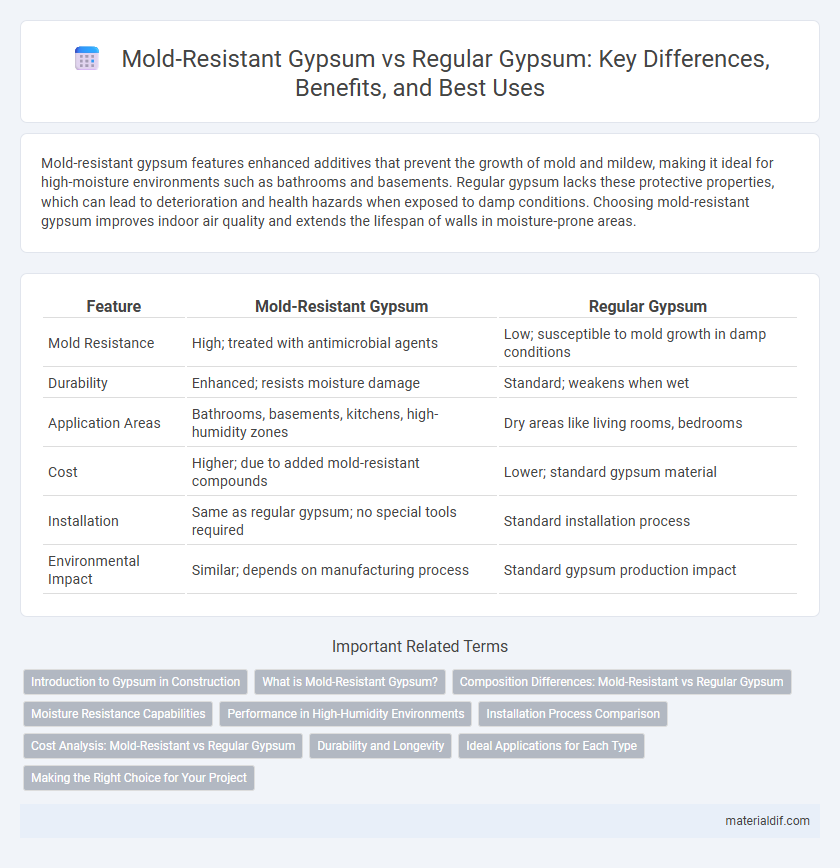Mold-resistant gypsum features enhanced additives that prevent the growth of mold and mildew, making it ideal for high-moisture environments such as bathrooms and basements. Regular gypsum lacks these protective properties, which can lead to deterioration and health hazards when exposed to damp conditions. Choosing mold-resistant gypsum improves indoor air quality and extends the lifespan of walls in moisture-prone areas.
Table of Comparison
| Feature | Mold-Resistant Gypsum | Regular Gypsum |
|---|---|---|
| Mold Resistance | High; treated with antimicrobial agents | Low; susceptible to mold growth in damp conditions |
| Durability | Enhanced; resists moisture damage | Standard; weakens when wet |
| Application Areas | Bathrooms, basements, kitchens, high-humidity zones | Dry areas like living rooms, bedrooms |
| Cost | Higher; due to added mold-resistant compounds | Lower; standard gypsum material |
| Installation | Same as regular gypsum; no special tools required | Standard installation process |
| Environmental Impact | Similar; depends on manufacturing process | Standard gypsum production impact |
Introduction to Gypsum in Construction
Gypsum is a widely used building material known for its fire resistance, ease of installation, and smooth finish in drywall applications. Mold-resistant gypsum contains special additives that inhibit mold growth, enhancing durability in high-humidity environments compared to regular gypsum. This makes mold-resistant gypsum a preferred choice for areas prone to moisture, such as bathrooms and basements, ensuring longer-lasting wall integrity and improved indoor air quality.
What is Mold-Resistant Gypsum?
Mold-resistant gypsum is a specialized drywall product treated with antimicrobial agents to inhibit mold and mildew growth in moisture-prone areas. Unlike regular gypsum, which lacks these protective treatments and is more susceptible to mold damage, mold-resistant gypsum enhances durability and indoor air quality in bathrooms, kitchens, and basements. This type of gypsum board typically features a moisture-resistant core and a specially coated paper facing designed to withstand humid environments.
Composition Differences: Mold-Resistant vs Regular Gypsum
Mold-resistant gypsum incorporates additives such as antimicrobial agents and fiberglass mesh that inhibit mold growth, while regular gypsum primarily consists of calcium sulfate hemihydrate without mold-resistant treatments. The enhanced composition of mold-resistant gypsum includes organic or inorganic compounds designed to improve moisture resistance and durability in high-humidity environments. Regular gypsum lacks these specialized components, making it more susceptible to mold development and degradation when exposed to moisture.
Moisture Resistance Capabilities
Mold-resistant gypsum contains additives such as fiberglass and wax that enhance its moisture resistance, significantly reducing the risk of mold growth in damp environments. Regular gypsum lacks these specialized components, making it more susceptible to water absorption and subsequent mold development when exposed to high humidity or leaks. This difference in moisture resistance makes mold-resistant gypsum ideal for use in bathrooms, basements, and other areas prone to excess moisture.
Performance in High-Humidity Environments
Mold-resistant gypsum contains additives like fiberglass mesh and antimicrobial agents that significantly reduce mold growth and moisture absorption, ensuring durability in high-humidity environments. Regular gypsum, lacking these enhancements, tends to absorb moisture, promoting mold development and compromising structural integrity over time. Performance tests reveal mold-resistant gypsum maintains its strength and appearance in bathrooms, kitchens, and basements, outperforming regular gypsum in moisture-laden conditions.
Installation Process Comparison
Mold-resistant gypsum features a specialized installation process that involves using moisture-resistant joint compounds and tape to enhance durability in damp environments. Unlike regular gypsum, which is more susceptible to water damage and requires standard installation materials, mold-resistant gypsum installation emphasizes sealing and moisture control to prevent mold growth. This process difference ensures longer-lasting wall performance in areas prone to humidity.
Cost Analysis: Mold-Resistant vs Regular Gypsum
Mold-resistant gypsum typically costs 20-30% more than regular gypsum due to its specialized additives that inhibit fungal growth. Despite the higher initial investment, mold-resistant gypsum can reduce long-term expenses related to mold remediation, maintenance, and potential health issues. In environments prone to moisture, this cost differential often translates to improved durability and savings on repair or replacement services.
Durability and Longevity
Mold-resistant gypsum contains antimicrobial additives that significantly enhance its durability by preventing mold growth even in high-moisture environments, unlike regular gypsum which is more prone to deterioration over time. This increased resistance to mold not only extends the longevity of mold-resistant gypsum but also maintains its structural integrity and aesthetic appearance for longer periods. Regular gypsum, lacking these protective features, tends to degrade faster, resulting in reduced lifespan and potential health hazards due to mold proliferation.
Ideal Applications for Each Type
Mold-resistant gypsum is ideal for high-moisture environments such as bathrooms, kitchens, and basements due to its enhanced resistance to mold growth and moisture damage. Regular gypsum suits dry, interior spaces like living rooms and bedrooms where moisture exposure is minimal and cost-efficiency is a priority. Choosing the appropriate gypsum type ensures durability and healthy indoor air quality tailored to environmental conditions.
Making the Right Choice for Your Project
Mold-resistant gypsum contains specialized additives such as fiberglass and antimicrobial agents that inhibit mold growth, making it ideal for damp or high-humidity environments like bathrooms and basements. Regular gypsum lacks these protective properties, increasing the risk of mold development and potential structural damage over time. Selecting mold-resistant gypsum ensures enhanced durability, improved indoor air quality, and compliance with building codes focused on moisture-prone areas.
Mold-resistant gypsum vs Regular gypsum Infographic

 materialdif.com
materialdif.com